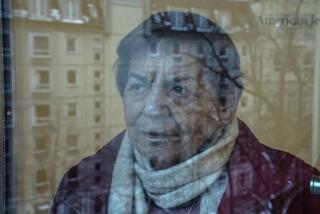‘Crossroads’ Celebrates Enduring Culture
- Share via
Oren Rudavsky and Yale Strom’s warm and bracing hourlong documentary “At the Crossroads: Jews in Eastern Europe Today” (at the Monica 4-Plex) is preceded--very effectively--by two 10-minute travelogues, “Jewish Life in Cracow” (1939) and “A Day in Warsaw” (1938), which reveal the richness and diversity of Jewish life in Poland that existed since the 12th Century but was all but obliterated by the Holocaust.
Indeed, at the beginning of “At the Crossroads” we are told that in 1939 Poland had a Jewish population of 3.5 million; Hungary, 650,000; and Czechoslovakia, 253,000. Fifty years later, there were only 12,000 Jews in Poland, 100,000 in Hungary and 15,000 in Czechoslovakia.
Inevitably, a sense of loss pervades this film, yet it is decidedly not downbeat. Rather, it celebrates the Jewish culture that has survived in klezmer music--Strom is a klezmer violinist--that joyous, exuberant traditional music of Eastern European Jewry. The film, which has that blend of astuteness and folksiness typical of a Les Blank documentary, also expresses the hope for a revival of Judaism in the onetime Iron Curtain countries now that communism has crumbled.
“At the Crossroads” suggests that being Jewish in Eastern Europe today can mean different things to different generations. For some, especially younger people, Jewishness is more a question of identity rather than faith; for older people, it means keeping the tenets of that faith despite all odds (in some communities there are so few Jews left that keeping kosher has become an impossibility.)
In accenting the positive, the filmmakers try for an ingratiating patchwork effect, skipping among the three countries often to the point of confusion. (However, had they moved from one country to the next sequentially, they would have had to provide a more specific historical context, resulting in a far more somber film than they clearly desired.)
Hungary, with the largest Jewish population of the three countries, has of course the best chance at some kind of valid renaissance of Judaism. Yet in Warsaw, a landmark concert by American Jewish rabbi Shlomo Carlebach in 1989--an occasion that the filmmakers state could not have happened one year earlier--draws a cheering, sold-out crowd, attracting many young Gentiles curious about a virtually eradicated culture. In one instance, the filmmakers speak with a group of Polish-Jewish yuppies who argue over whether to study Yiddish or Hebrew--only to admit that they’ve found no one yet to teach them either language.
The film’s inevitably poignant yet determinedly positive spirit is embodied in a staunch elderly Hungarian-Jewish woman who survived Auschwitz--her husband did not--only to have her family’s large farm confiscated by the communist government.
Yet she manages to push away sad memories of catastrophic losses and enjoy a rare opportunity to speak in English. There’s a sweet sadness in this elegant survivor, interlaced with humor and courage, that permeates all of “At the Crossroads” (Times-rated family), making it well nigh irresistible.
‘At the Crossroads: Jews in Eastern Europe Today’
An Arthur Cantor Film release. Written, produced and directed by Oren Rudavsky and Yale Strom. Co-producer Elinor Schull. Cinematographer Rudavsky. Editor Richard Smigielski, Mia DeBethune. Music director Strom. Sound editor Steve Visscher. Running time: 59 minutes.
Times-rated Family (for all ages, although small children should be accompanied by adults).
More to Read
Only good movies
Get the Indie Focus newsletter, Mark Olsen's weekly guide to the world of cinema.
You may occasionally receive promotional content from the Los Angeles Times.










